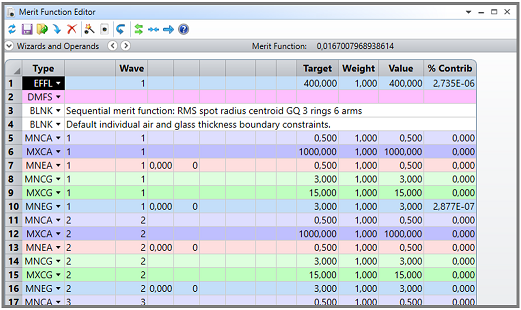
This node allows you to use OpticStudio files (.zmx, .zos) within an optiSLang workflow. When you open a file in the node, the parameters and results are displayed.
Setup
A few steps are required to prepare the OpticStudio project for a variational study with optiSLang. Lens data parameters that are selected to undergo variations in optiSLang must be set to variable solver type.

All simulation outputs to be processed in optiSLang must be defined in the Merit function editor. Only responses defined there can be used in optiSLang for further analysis.

The optiSLang Solver wizard extracts the parameters and responses after selecting the OpticStudio file (.zos/.zmx).
Parameters and Responses
The Customization:Customized integrations use tree view setting controls whether the parameters and responses are presented as list or tree structure. You can change it in the optiSLang Settings dialog box. After changing the setting, restart optiSLang.
If sequential and hybrid non-sequential raytracing [Mode: "Sequential"] is used in the Zemax model, optiSLang provides access to the content of the Lens Data Editor to select inputs as parameters. Variables that are already defined are listed separately.
Otherwise if pure non-sequential raytracing [Mode: "Non-sequential"] is used the Non-Sequential Component Editor is shown to define inputs as parameters. Variables that are already defined are listed separately.
In both modes, the Merit Function Editor is available to select outputs as responses. All inputs and outputs can be registered using drag-and-drop.
Settings
The node provides settings for the installation path. This is the path to the OpticStudio installation folder, which will be automatically detected by the node. In the case where there is another version of OpticStudio also installed, you can specify the installation path of the version you want to use.
| Tab | Name | Default Value |
|---|---|---|
| General | Installation path | C:\Program Files\Ansys Zemax OpticStudio 2023 R2.00\ |
Run Options
This node has general Run Options. The number of supported options is individual for each node.
Parallelization is supported.
Tutorial Examples
Contact Ansys support (support@ansys.com) for tutorial examples or visit the Ansys Learning Hub.
Versions and Requirements
Operating Systems
Windows.
Versions
See the Supported Integration Versions table.
Ansys Zemax OpticStudio (AZOS) is supported.
Troubleshooting
Linux is currently not supported.
If you want to check that the OpticStudio installation path is correct, it is defined in the OpticStudio .ini file (C:\Users\<user name>\AppData\Roaming\Ansys\optiSLang\optiSLang_opticStudio.ini).


